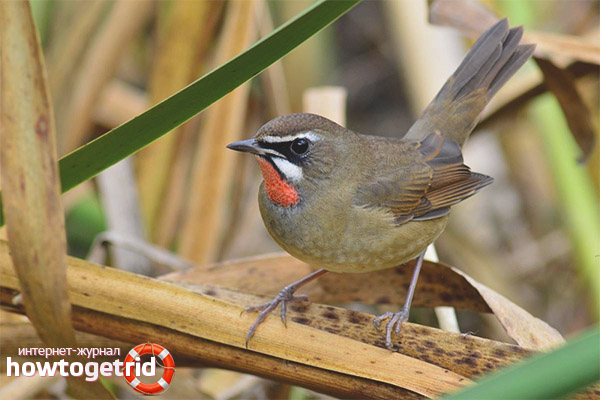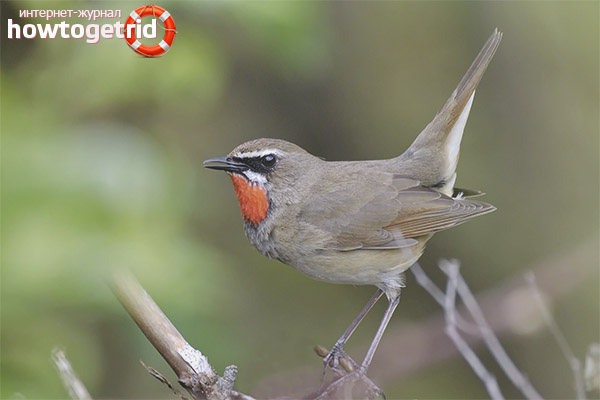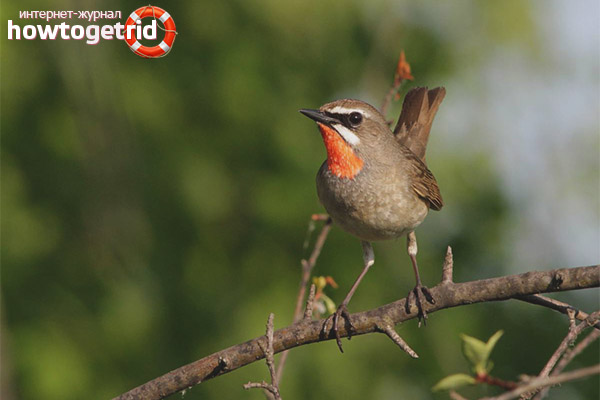The content of the article
Nightingale - a simple, seemingly bird, does not stand out among others in appearance or color. But the bird, thanks to its clear, clear and amazingly beautiful voice, is known to all. For the most part, people believe that nightingales are found mainly in the area of Kursk and Tula. But this is not entirely true, and we will talk about the red-necked nightingale, which lives in the North Asian regions of Russia.
Appearance
The red-necked nightingale is a representative of the order Passeriformes, the thrush family. Describing it is quite difficult - the appearance is so plain.
It is small in size - it is 16-18 cm long, weighs 20-28 g, and looks and size similar to an ordinary nightingale. The same brown-olive top, whitish abdomen, wings and tail are covered with a light red coating, as if wearing a black mask trimmed with white stripes trimmed on the upper and lower sides. The only feature is that the male’s neck and throat are covered with a kind of “tie” of bright red color with dark stripes.
Females outwardly differ from males - their throats are whiter, their red ties appear with light strokes, their little “eyebrows” and “mustaches” are less contrasted, and the color of their feathers is duller than that of males.
Habitat
It lives beyond the Ural Mountains from the Asian side in Eastern Siberia, Middle and East West. Lives up to Kamchatka and Sakhalin, lodges in the north of Mongolia and in the southern Chinese mountains. Inhabits the undergrowth and shrubby taiga zone, loves marshy areas with high humidity, overgrown with small trees. The red-necked nightingale is difficult to see with the naked eye - it hides in the thickets of grass and shrubs, keeping close to the ground.
Nesting and breeding
The female lays eggs on fine May days, in a clutch of two to six pieces, most often 4-5 eggs of bluish, grayish-green or light color, decorated from the blunt end with red pigmentation or brownish spots.
Only the female incubates the testes for two weeks. In early June, chicks covered with a rare fluff appear on the light. Within 11-13 days, both parents are engaged in their feeding. At the beginning of the second summer month, the chicks, who still cannot fly, leave the nest and live on the ground. Their parents teach them to disguise themselves, to hide from danger in the grass thickets and continue to provide food. With the onset of August, young growth stands on the wing and leaves its parents, leaving for an independent life.
Wintering

Being migratory birds, red-necked nightingales fly to warmer climes in late summer - early fall. Winters in Africa, Iran and on the Mediterranean coast.
Food
In food, the red-eyed nightingale is undemanding, feeds mainly on animal food - various kinds of insects such as weevils, bedbugs, leaf-eaters and nutcrackers, spiders, digs out worms from the ground. He does not like to hunt in the air, and he does this very rarely. With the onset of cold weather, when there are few insects, eats berries and fruits with pleasure.
Singing
For many centuries, nightingales have been considered unsurpassed singers. And indeed - their bewitching voice penetrates the soul, making you worry and enjoy the bewitching trills. Singing consists of the so-called “tribes”, bearing different names depending on the order - “whistle”, peals, “fractions”. The bird sings at any time - at least during the day, at least in the evening, at least in the morning. In the 19th century, landowners and nobles specially acquired nightingales and kept them in a cage in order to delight the hearing with singing.
Nightingales are good imitators and imitators, it is worth a wonderful singer to appear in the district, as all the birds living in the vicinity begin to sing even better than before.
Interesting Facts
- The singing of the Red-necked is very beautiful, perhaps, would not be inferior to the songs of the recognized masters of this business - the Kursk nightingales. But shorter - the red-necked nightingale quickly exhales.
- If you frighten a bird, it switches from beautiful singing to whistling and rattling.
- Only males sweeten the human ear by singing, caring for the lady of the heart and giving her various signs of attention, but when the chicks appear from the eggs, the father stops singing and is only concerned with providing the heirs with food.
- Scientists have found that nightingale singing is not an inborn skill. It is acquired when the chick listens to parental trills and learns to sing from them. They conducted an experiment - they fed the baby bird artificially, without the participation of parents. Of course, he then sang, but he sang much worse than the chicks who grew up with their parents.
- During singing, males strictly wait for their turn to perform and do not try to wedge themselves in someone else's performance.
- Ornithologists have found a pattern - in the daytime and evening, nightingales sing, guarding their site and marking the territory. And only at night, singing is intended to attract female birds.
- The bird spends a huge amount of energy on singing, and for its full restoration the nightingale can eat almost as much food as it weighs itself.
- The flight speed of this little bird can reach 50 kilometers per hour.
The nightingale has been living in nature for 10-11 years, and all this time it is returning to the same place where it once made a nest. The fact is that nightingales are very picky about choosing a place of residence. They don’t want to search for a new place and begin to build housing anew.
Video: Nightingale (Luscinia calliope)











Submit